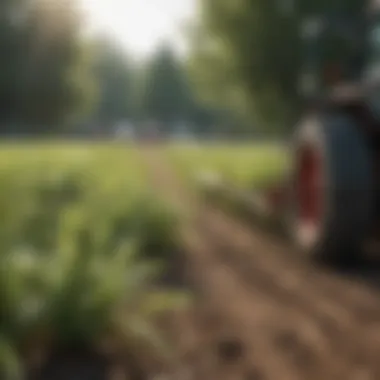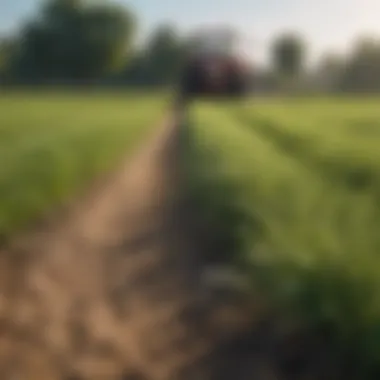Understanding Weed Spray Costs per Acre


Overview of the Topic
Definition and Importance
Current Trends
Recently, there has been a shift towards more sustainable weed management practices. Integrated weed management combines chemical solutions with cultural methods. This approach can help reduce costs while minimizing environmental impacts. Farmers are more frequently exploring precision agriculture tools that apply herbicides more efficiently. This saves not just on product usage but also labor and time.
Key Techniques and Practices
Step-by-Step Guide
- Identify Weeds: Before selecting a herbicide, identify the weed species present. This influences the choice of product.
- Select Herbicide: Based on the weed type, choose an appropriate herbicide. Systemic and contact herbicides serve different purposes.
- Calculate Acreage: Measure the area of land to be treated. Knowing the total acres helps in budget planning.
- Determine Application Method: Decide whether to use ground or aerial application. Each has cost implications. Ground application is typically cheaper but may not be as effective on large fields.
- Apply Herbicide: Follow the manufacturer's instructions for mixing and application.
- Monitor Effectiveness: After application, observe the effectiveness. Adjustments may be necessary for future applications.
Tools and Equipment Needed
- Sprayers: Choose between boom sprayers for large fields or backpack sprayers for smaller areas.
- Protective Gear: Always wear gloves and masks during application to avoid chemical exposure.
- Measuring Tools: Accurate measuring instruments ensure the right amount of herbicide is used.
Challenges and Solutions
Common Obstacles
One common challenge is the variability of weed species across different regions. The emergence of herbicide-resistant weeds can make management more difficult. Moreover, fluctuating prices of herbicides due to market dynamics can strain farmers' budgets. Environmental regulations can also limit the types of herbicides that can be used.
Innovative Solutions
Using advanced technology can help overcome some of these challenges. Precision application equipment minimizes herbicide use and targets specific weeds. Utilizing crop rotation and cover crops can naturally suppress weed growth, reducing reliance on chemicals. Engage with local agricultural extension services for guidance on best practices and locally suitable herbicides.
The effective management of weed costs per acre not only impacts profit margins but also contributes to sustainable farming practices.
Preface to Weed Control
Weed control is a critical component in agriculture and land management. The presence of weeds can significantly impact the yield and quality of crops. They compete with desired plants for nutrients, water, and sunlight, ultimately hindering productivity. Moreover, some weeds can harbor pests and diseases, further complicating an already challenging agricultural landscape.
Understanding the importance of effective weed management is essential for farmers and agricultural enthusiasts. It goes beyond just keeping fields tidy. Implementing proper weed control methods can lead to higher crop yields, reduced labor costs, and optimal use of resources. In today's competitive farming environment, finding cost-effective weed control solutions is crucial.
Weed management practices must be tailored to specific farming systems and regional conditions. Different weeds thrive in various climates and soils, making a one-size-fits-all approach ineffective. To achieve the best outcomes, farmers must assess their specific weed problems and choose the appropriate control techniques.
Regular monitoring and evaluation of weed populations help in planting decisions and adjustment of techniques. This proactive approach minimizes the likelihood of weeds becoming a costly problem, ultimately protecting both time and financial investment. Furthermore, integrating weed management strategies with overall crop management enhances sustainability in agricultural practices.
Cost Factors in Weed Spraying
Understanding the cost factors in weed spraying is crucial for effective weed management. Each element impacts the final expense, making it necessary for farmers and agricultural professionals to optimize their weed control strategies. Cost factors can include herbicides selection, application methods, and equipment costs. Knowing how these factors interrelate helps individuals make informed choices that can improve both economic efficiency and agricultural productivity.
Type of Herbicides
Selective versus Non-Selective
Selective herbicides target specific types of weeds while leaving crops unharmed. This attribute makes them a popular choice among farmers who wish to protect their crops. Their ability to manage weeds without damaging desired plants is a key characteristic. On the other hand, non-selective herbicides, like glyphosate, kill all vegetation. This broad-spectrum approach can be effective for controlling tough weeds, but it raises concerns regarding crop damage and environmental impact. Therefore, the choice between selective and non-selective herbicides depends in part on land use and specific weed problems faced.
Pre-Emergent versus Post-Emergent
Pre-emergent herbicides prevent weed seeds from germinating. They are applied before weeds break through the soil. This proactive approach can reduce the overall cost of weed management by minimizing the need for additional treatments later. Conversely, post-emergent herbicides are used after weeds have emerged. While they can be effective, they may necessitate several applications, leading to higher costs over time. The choice depends on timing, costs, and specific weed species that are present in the field.
Organic Alternatives


Organic alternatives to traditional herbicides are becoming more significant in the industry. These options are derived from natural substances and can be appealing to those aiming for sustainable practices. The key characteristic of organic herbicides is that they often have lower environmental impact. However, their effectiveness may vary, and they can be more expensive. Farmers should evaluate the pros and cons based on their specific situation and compliance with organic standards.
Application Methods
Ground Application
Ground application involves using tractors or sprayers to apply herbicides directly to the ground. This method is often more precise and can be cost-effective for smaller areas. The unique feature of ground application is its ability to reach every corner of the field, optimizing herbicide usage. However, fields with rough terrain may create challenges.
Aerial Application
Aerial application uses aircraft to distribute herbicides across the field. This method covers large areas quickly and efficiently. It is particularly beneficial in regions with dense weed populations. The downside of aerial application includes higher costs and potential drift issues to neighboring crops or ecosystems. Knowledge of local regulations is essential when considering this method.
Manual Application
Manual application of herbicides typically involves applying them by hand or using small equipment. This method allows for targeted application in areas where weeds are concentrated. Manual application is labor-intensive but can have lower initial costs. Farmers must weigh its advantages against the time and labor required, especially on larger properties.
Equipment and Labor Costs
Purchasing Equipment
Purchasing equipment for herbicide application is a significant investment. This choice may lead to long-term savings through efficient application and reduced labor costs. Modern equipment offers precision technology, reducing costs associated with over-application. However, upfront costs can be high. Careful assessment of return on investment is vital when considering new purchases.
Rental Options
Rental options for equipment are often available and provide flexibility. This approach allows farmers to access necessary machines without the burden of ownership costs. Renting is beneficial for those who need equipment only seasonally. However, the risks include potential limitations in availability during peak seasons when demand is high.
Labor Requirements
Labor requirements play an important role in the overall cost of weed spraying. Hiring skilled labor can increase costs but may lead to more effective application and lower long-term expenses. Understanding the labor availability in the local market is essential. Automation technology, like drones, is also influencing labor needs, potentially reducing reliance on manual labor in the future.
Regional Variations in Weed Spraying Costs
Understanding how regional differences impact the cost of spraying weeds is essential for effective weed management. The costs associated with herbicide application can fluctuate based on several local factors. This section will delve into the geographic and climatic influences that contribute to these costs.
Impact of Geography
Geography plays a critical role in the cost of weed spraying. Different regions have varying types of weeds, soil characteristics, and farm sizes that affect the approach to weed control. For instance, farmers in the Midwest might deal with corn and soybean weeds, while those in the South might face specific challenges from diverse perennial weeds. The local agricultural practices also differ, demanding varying approaches to herbicide application.
Furthermore, transportation costs can add to the overall expense of herbicide application. In remote areas, the distance to supply stores or the availability of products may affect pricing. Often, regional suppliers might have unique pricing structures based on the demand and availability of herbicides in their vicinity.
Moreover, local government policies and regulations regarding pesticide use can also impact the cost structures, influencing what products can be used and how they can be applied. Farmers need to understand these local factors when budgeting for weed control efforts to make informed decisions.
Climate Considerations
Climate is another significant factor that can influence the cost to spray weeds. Weather conditions can affect not only the timing of the application but also the effectiveness of the herbicides used. Each herbicide has an optimal temperature and moisture requirement for application. For example, herbicides may need to be applied before rainfall to increase efficacy, or at certain temperatures to avoid plant stress.
Additionally, climate impacts the prevalence and types of weeds. In warmer climates, certain weeds may thrive, necessitating more frequent treatments, which multiply costs over time. Moreover, dry seasons may compel farmers to invest in additional irrigation to ensure proper application of herbicides.
Understanding these climatic elements is vital for farmers to effectively plan and perform weed control while managing their budgets. By adapting herbicide application methods to local climate conditions, farmers can potentially reduce costs and improve efficiency.
"Recognizing local geography and climate is key to creating an effective and economical weed management strategy."
In summary, regional variations in weed spraying costs are influenced by geographic and climate-related factors. Awareness and adaptation to these differences can lead to better budget management and optimized weed control strategies.
Cost Estimation Techniques
Understanding the cost estimation techniques for weed spraying is essential for anyone involved in agriculture. These techniques assist farmers and agricultural enthusiasts in budgeting and optimizing their expenses effectively. Accurate estimates can set the groundwork for strategic planning. Adopting the right methods can lead to better resource allocation, ensuring that the desired results are achieved without financial overruns.


Estimating Herbicide Quantity
Estimating the herbicide quantity required for a specific area is crucial for effective weed control. This estimation is based on several factors, including the type of weeds present, the growth stage of those weeds, and the size of the treatment area. Formulating an accurate estimate involves understanding the label instructions associated with herbicides. Most products provide application rates in terms of ounces or liters per acre.
For instance, if a labeling suggests using 2 quarts of a certain herbicide per acre, and a farmer is planning to spray 10 acres, the calculation would be straightforward:
- Total Herbicide Needed: 2 quarts/acre × 10 acres = 20 quarts.
However, environmental conditions can also impact the required amount. Factors like soil type or moisture levels influence herbicide effectiveness. Thus, farmers should adjust their calculations accordingly, taking into account any necessary buffer zones or drift management, as these can also affect quantity estimates.
Calculating Application Rates
Calculating application rates is another integral aspect of effective weed management. This refers to how much herbicide is applied per unit area over time. Factors influencing application rates include the method of application, the equipment used, and the specific herbicide's characteristics. It is determined primarily by the type of equipment, whether ground, aerial, or manual application is being employed.
To illustrate, consider the following methods:
- Ground Application: This usually offers more precise control, and farmers need to consider the speed of the equipment and the desired coverage per acre.
- Aerial Application: This method may cover larger areas faster but could also lead to uneven dispersion, requiring thorough calculation to ensure uniformity.
- Manual Application: This method requires careful measurement to avoid wastage or under-application.
Farmers can use specific formulas to calculate the application rate. For example, if applying a liquid herbicide at 1 gallon per acre, and the sprayer outputs 2 gallons per minute, the coverage rate would look like this:
Accurate rate calculations help in determining total utilization costs, thus aiding in budget planning. Furthermore, proper application techniques prevent environmental contamination, safeguarding both crop yield and ecosystem health.
Economic Considerations in Weed Management
Effective weed management is a critical aspect of agricultural productivity. It involves understanding the economic implications to make informed decisions about herbicide application. Costs associated with spraying weeds can significantly affect farm profits. The economic aspect goes beyond the initial application cost. It also includes potential yield improvements, long-term soil health, and sustainability factors. Evaluating these economic considerations helps in determining the most cost-efficient practices suitable for specific farming operations.
When growers understand the financial impact of weed control, they can better strategize their investment in herbicides, equipment, and labor. Optimizing weed management has the potential to provide a significant return on investment over time, reinforcing its importance in overall agricultural success. This section will explore two key economic facets: return on investment and budgeting for weed control.
Return on Investment
Assessing the return on investment, or ROI, from weed control activities is essential. A well-executed weed management program can lead to increased crop yields, which translates directly to higher profits. Therefore, accurate calculation of ROI is necessary.
- Calculate Cost of Herbicides and Application: Identify total expenses incurred in purchasing herbicides and for their application.
- Estimate Yield Increases: Analyze historical data or conduct trials to quantify the expected yield increases resulting from effective weed control.
- Compare Costs and Revenue: Calculate the net benefit by comparing the yield increases (converted to revenue) against the costs of weed management.
This process can repeat over several seasons. By tracking expenses versus benefits over time, farmers can fine-tune their strategies. This means focusing on which products and methods yield the best results for their specific conditions.
Budgeting for Weed Control
Budgeting for weed control is an essential practice in agricultural management. A detailed budget aids in forecasting cash flows and ensuring funds are allocated correctly to weed management efforts.
- Identify Fixed and Variable Costs: Start by recognizing fixed costs, such as equipment purchase or lease, and variable costs like herbicides and labor costs.
- Seasonal Factors: Consider the schedule of the applications and how seasonal variations may cause fluctuations in costs.
- Establish Emergency Funds: Create a contingency buffer for unexpected weed problems. This can cover unplanned herbicide applications or increased labor needs.
Utilizing technology can enhance budgeting precision. Data analytics tools can offer insights into historical weed infestations and cost. This data enables more accurate budgeting and financial planning for future seasons.
"Through careful budgeting and proactive management, growers can ensure they maximize their financial returns while effectively controlling weeds."
Regulatory Compliance and Costs
Understanding the regulatory landscape surrounding herbicide application is crucial for anyone involved in agricultural practices. Regulatory compliance impacts the cost of spraying weeds per acre significantly. Adhering to legal standards ensures that agricultural practices do not harm the environment, human health, or the integrity of the agricultural sector.
Understanding Local Regulations
Local regulations vary widely based on geography and specific agricultural practices. Farmers must be well informed about the laws that govern herbicide use in their area. This might include limitations on certain chemicals, application timing, and specific documentation or reporting requirements.


Benefits of Compliance:
- Legal Protection: Following local guidelines protects against legal actions or fines.
- Environmental Safeguards: Regulations often aim to protect groundwater and surrounding ecosystems.
- Market Advantages: Compliance may enhance marketability of crops, particularly in organic or health-conscious segments.
While regulatory frameworks can seem tedious, they also provide a framework that increases agricultural sustainability.
Licensing and Certification for Herbicide Application
Licensing and certification are essential for proper herbicide application. In many regions, only licensed applicators are permitted to handle certain chemicals. This requirement stems from the potential hazards associated with misuse, including health risks and environmental damage.
Obtaining necessary certifications usually involves:
- Completing educational courses
- Passing examinations
- Meeting ongoing education requirements to renew licenses
Key Points on Certifications:
- Informed Usage: Licensed applicators receive training on safe and environmentally friendly practices.
- Regulatory Alignment: Certification ensures that applicators are aware of current laws and best practices.
- Professional Credibility: Licensed individuals often gain trust among clients and peers in the agricultural community.
Best Practices for Cost-Effective Weed Control
Controlling weeds effectively is essential for maximizing agricultural productivity. Utilizing best practices not only helps in managing weed populations but also contributes to cost efficiency. The aim is to achieve a balance between economic viability and successful weed control. Understanding and implementing effective strategies can significantly impact both short-term expenses and long-term outcomes.
Integrated Pest Management Strategies
Integrated Pest Management (IPM) is a holistic approach to managing pests, including weeds. IPM combines various management practices to reduce reliance on herbicides. This method focuses on understanding the life cycle of weeds and their interaction with crops. Effective IPM strategies often lead to lower costs.
Key components of IPM include:
- Cultural Practices: Crop rotation and diversification can reduce weed pressure. Certain crops can outcompete weeds, thus minimizing their growth.
- Biological Control: Introducing natural enemies of weeds can reduce their spread. Some farmers use insects or pathogens to target specific weed species.
- Mechanical Control: Regular mowing or tilling can physically suppress weed growth. Mechanical methods can be very effective when used alongside other strategies.
Implementing IPM not only reduces costs related to herbicides but also promotes sustainable farming practices. By integrating these strategies, growers can manage weed populations in a more environmentally friendly manner.
Utilizing Technology for Precision Application
Technology plays a crucial role in modern agriculture, particularly in the context of weed control. Utilizing advanced technologies for precision application can significantly reduce herbicide costs while enhancing efficiency.
Precision agriculture techniques include:
- GPS Mapping: This technology helps in precisely mapping weed-infested areas. Farmers can target specific regions rather than spraying indiscriminately.
- Drones: Drones equipped with imaging technology can assess weed conditions and identify patches needing treatment. This allows for targeted herbicide application, reducing waste and expense.
- Smart Sprayers: These systems adjust the herbicide application rate based on real-time data. This capability ensures that only the necessary amount of product is used, minimizing costs and environmental impact.
Incorporating technology not only optimizes herbicide use but also enhances the overall efficiency of weed management processes. Investing in these technologies can lead to substantial savings over time, as well as better crop yields.
In summary, the combination of Integrated Pest Management and cutting-edge technology forms a robust framework for effective and cost-efficient weed control. By adopting these practices, farmers can reduce expenses while ensuring sustainable farming operations.
Culmination and Future Trends
As the agricultural landscape continuously evolves, understanding the importance of effective weed spraying becomes paramount. It is not just about the immediate costs but also about the long-term benefits that efficient weed control can bring to productivity and sustainability. The trends shaping the future of weed management highlight the need for innovation in practices and equipment.
Emerging Technologies in Weed Control
Technology is at the forefront of advancing weed control methods. Precision agriculture, for instance, leverages data analytics and GPS technology to optimize herbicide application. This approach minimizes waste and maximizes coverage. Using drones for aerial spraying has emerged as a viable option, enabling farmers to cover large areas rapidly and efficiently. Furthermore, advancements in herbicide development are leading to products that are more effective and environmentally friendly. These innovations not only reduce the cost per acre but also mitigate the environmental impact.
"The integration of technology in farming practices can significantly reduce operational costs and improve outcomes in weed management."
Maintaining a focus on these technologies is essential for farmers who want to stay competitive. Companies that develop software for crop management can also provide insights into the best timing and methods for weed spraying, based on various environmental factors. The more precise the application, the lower the costs, making technology a vital element in contemporary agricultural practices.
Sustainable Practices Moving Forward
Sustainability in agriculture is no longer optional; it is imperative. The cost-effectiveness of weed management can be greatly enhanced by implementing sustainable practices. For example, utilizing cover crops not only suppresses weeds but also improves soil health, leading to a more robust ecosystem. Integrated Pest Management (IPM) strategies can effectively combines biological, cultural, and mechanical controls with limited herbicide use.
Farmers are encouraged to explore organic herbicides as part of their management strategy. While the initial costs may be higher, the long-term benefits often outweigh these investments through enhanced soil quality and reduced chemical runoff. Moreover, consumer preferences are shifting towards organic products, creating a market that incentivizes sustainable practices.
In summary, the future of weed control hinges on adopting a dual approach: embracing emerging technologies while committing to sustainable practices. Both aspects can effectively lower costs and improve the health of agricultural systems, ensuring farmers can maintain productivity in an increasingly competitive market.



